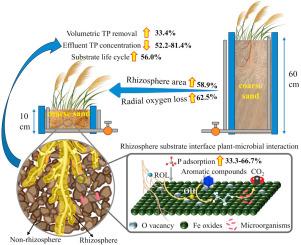当前位置:
X-MOL 学术
›
Water Res.
›
论文详情
Our official English website, www.x-mol.net, welcomes your
feedback! (Note: you will need to create a separate account there.)
Quantifying the underestimated plant potential for phosphorus removal in constructed wetlands: Revealing the mediating mechanism of radial oxygen loss
Water Research ( IF 11.4 ) Pub Date : 2025-05-28 , DOI: 10.1016/j.watres.2025.123923
Dun Guo, Jingying Zhang, Wei Bian, Yanbin Chi, Bin Li, Qinting Ren, Lei Yang, Jun Lan, Yongxiang Ren
Water Research ( IF 11.4 ) Pub Date : 2025-05-28 , DOI: 10.1016/j.watres.2025.123923
Dun Guo, Jingying Zhang, Wei Bian, Yanbin Chi, Bin Li, Qinting Ren, Lei Yang, Jun Lan, Yongxiang Ren

|
Substrate adsorption is considered the primary phosphorus removal pathway in subsurface flow constructed wetlands (CWs), but the role of plants in this process remains underestimated. To clarify this issue, this study conducted root restriction by decreasing substrate depth from 60 cm to 10 and 20 cm to intensify the radial oxygen loss (ROL). On this basis, the resultant enhancement to soluble total phosphorus (TP) removal from late spring to early winter was quantified. Further, the underlying enhancing mechanisms were revealed by analyzing the P mass balance and substrate surface interfacial plant-microbial synergy. CWs shallower than 0.2 m significantly intensified ROL and root biomass, showing 33.4 % more volumetric P removal on average, and the increased rhizosphere P adsorption accounted for all increments. In the rhizosphere, ROL was activated by Fe (II) of Fe3 O4 on the substrate surface and produced solid-liquid interfacial-bounded ·OH. Aromatic compounds in root exudations, microbial metabolites, and influent organics that occupied P adsorption sites were mainly converted to aliphatic compounds by ·OH and further biodegraded, thereby re-exposing the adsorption sites. This process contributes to 65.1 % (9.41mgP/M·OH) of the volumetric efficiency increment, and the rest is owing to the ROL-induced P content increasing in extracellular polymeric substances. Larger root biomass created more rhizosphere substrates (accounting for 75.0 %, 56.4 %, and 16.1 % in 0.1, 0.2, and 0.6 m CWs, respectively), amplified the rhizosphere P removal increment, and durably more than halved the effluent TP. Intensifying ROL prolonged the substrate life cycle, and the effective mediation started after 40-day adaptive cultivation in shallow substrates. This study deepened the current theory and inspired CWs’ design and management.
中文翻译:

量化人工湿地中被低估的植物除磷潜力:揭示径向氧损失的中介机制
基质吸附被认为是地人工湿地 (CW) 中的主要除磷途径,但植物在这一过程中的作用仍然被低估。为了澄清这个问题,本研究通过将基质深度从 60 cm 减少到 10 和 20 cm 来加强径向氧损失 (ROL) 来限制根系。在此基础上,量化了从春末到初冬对可溶性总磷 (TP) 去除的增强。此外,通过分析 P 质量平衡和基质表面界面植物-微生物协同作用,揭示了潜在的增强机制。浅于 0.2 m 的 CWs 显著强化了 ROL 和根生物量,平均体积磷去除率提高了 33.4%,根际 P 吸附的增加占了所有增量。在根际,ROL 被衬底表面 Fe3O4 的 Fe (II) 活化,产生固液界面结合 ·哦。根系分泌物中的芳香族化合物、微生物代谢产物和占据 P 吸附位点的进水有机物主要通过·OH 并进一步生物降解,从而重新暴露吸附位点。该过程贡献了 65.1 % (9.41mgP/M·OH) 的体积效率增量,其余部分是由于 ROL 诱导的 P 含量在细胞外聚合物物质中增加。较大的根生物量产生了更多的根际基质(在 0.1、0.2 和 0.6 m CWs 中分别占 75.0 %、56.4 % 和 16.1 %),放大了根际 P 去除增量,并持久地将流出物 TP 减半以上。强化 ROL 延长了基质生命周期,在浅层基质中适应性培养 40 天后开始有效介导。 这项研究深化了当前的理论,并启发了 CWs 的设计和管理。
更新日期:2025-05-28
中文翻译:

量化人工湿地中被低估的植物除磷潜力:揭示径向氧损失的中介机制
基质吸附被认为是地人工湿地 (CW) 中的主要除磷途径,但植物在这一过程中的作用仍然被低估。为了澄清这个问题,本研究通过将基质深度从 60 cm 减少到 10 和 20 cm 来加强径向氧损失 (ROL) 来限制根系。在此基础上,量化了从春末到初冬对可溶性总磷 (TP) 去除的增强。此外,通过分析 P 质量平衡和基质表面界面植物-微生物协同作用,揭示了潜在的增强机制。浅于 0.2 m 的 CWs 显著强化了 ROL 和根生物量,平均体积磷去除率提高了 33.4%,根际 P 吸附的增加占了所有增量。在根际,ROL 被衬底表面 Fe3O4 的 Fe (II) 活化,产生固液界面结合 ·哦。根系分泌物中的芳香族化合物、微生物代谢产物和占据 P 吸附位点的进水有机物主要通过·OH 并进一步生物降解,从而重新暴露吸附位点。该过程贡献了 65.1 % (9.41mgP/M·OH) 的体积效率增量,其余部分是由于 ROL 诱导的 P 含量在细胞外聚合物物质中增加。较大的根生物量产生了更多的根际基质(在 0.1、0.2 和 0.6 m CWs 中分别占 75.0 %、56.4 % 和 16.1 %),放大了根际 P 去除增量,并持久地将流出物 TP 减半以上。强化 ROL 延长了基质生命周期,在浅层基质中适应性培养 40 天后开始有效介导。 这项研究深化了当前的理论,并启发了 CWs 的设计和管理。


















































 京公网安备 11010802027423号
京公网安备 11010802027423号